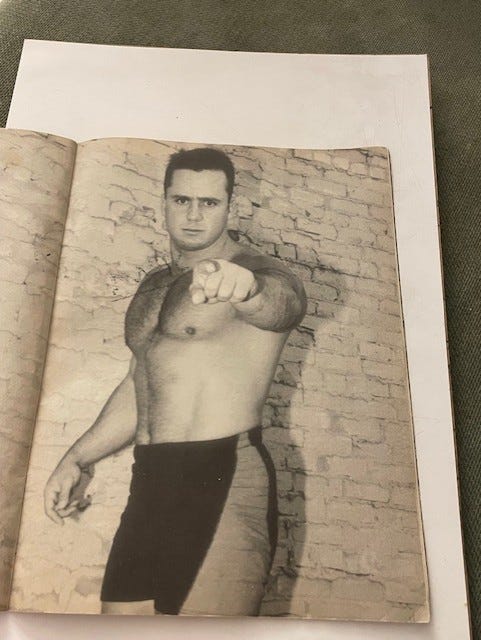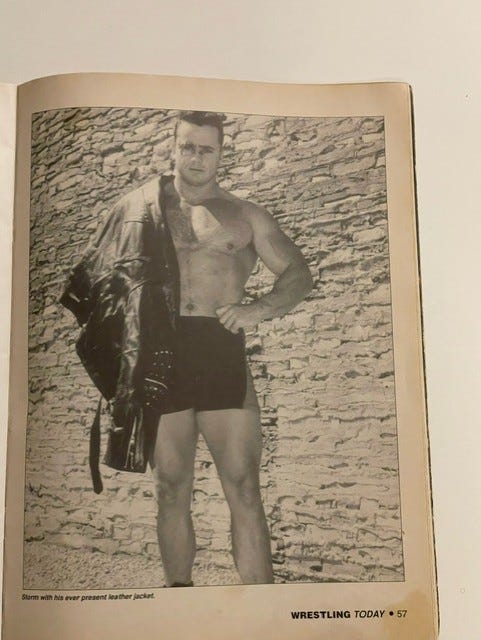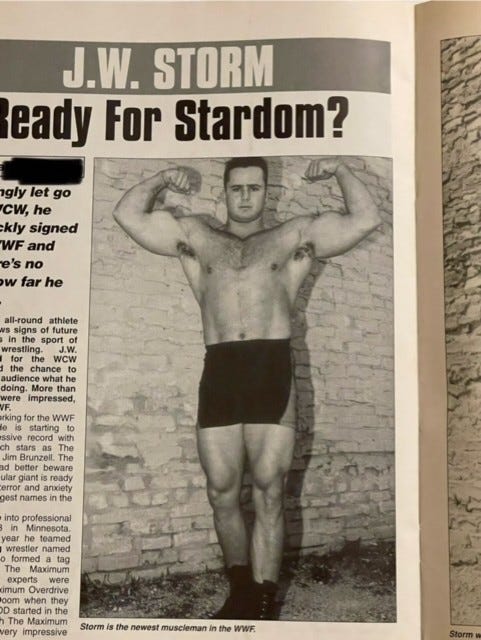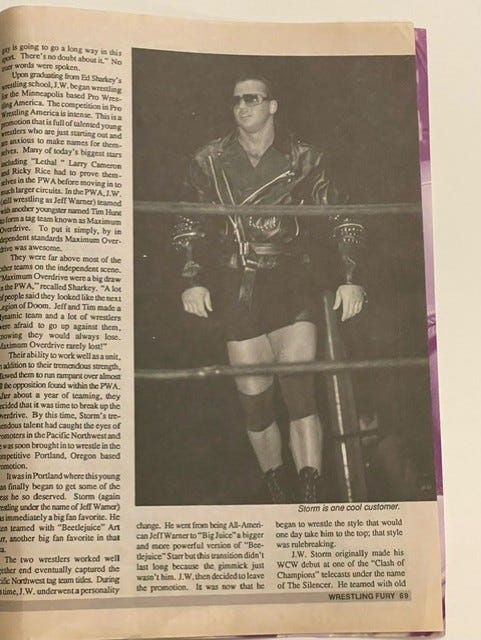
As a pro wrestling fan, writer and referee in the ‘90s, I took an ardent interest in talent I perceived to be rising stars with the potential to one day be in WWE or WCW.
The fan in me sought out their matches and cheered their performances on screen as I watched them develop further with each progressive match and promo.
In this era before the internet and social media, for those pro wrestlers who aspired to reach either WWE or WCW it could be challenging to get the attention of these promotions without some kind of personal connection.
As a wrestling magazine writer, when I saw a promising talent who also had a good attitude, I acted as an unofficial publicist for them.
I wrote articles about them for magazines, provided updates on them in the various magazine columns I wrote, and sent information on them to newsletter writers as well for further publicity.
When I was a referee, if a promising wrestler was interested in receiving critique of their in-ring and/or mic work, I was glad to offer my insights into their strengths as a performer and give suggestions on areas I thought that they could focus on developing further.
Of the many pro wrestlers who I wrote articles about in the early ‘90s, Rasta was my first pick of who I thought would become the biggest star in either WWE or WCW when signed. Somehow though Rasta never got signed by either promotion.
My second pick was J.W. Storm.
He did make it to the majors in pro wrestling, making appearances in both WCW and WWE just a few years after his pro wrestling debut in 1988.
J.W. was 6’5” 260 lbs., thickly muscled, had an intense ring presence, and was still in his early 20’s when I first saw him in 1990.
I had been supplied footage of him wrestling on an independent show from the year prior shortly after his in-ring debut, and I was highly impressed by his raw talent and look.
So much so, I referred to him in print as the next Lex Luger because I saw similarities in their on-camera demeanors and power wrestling style, as well as physiques, when comparing Storm to Luger ‘s early wrestling appearances.
Later that same year J.W. debuted in WCW and in early 1992 he was signed by WWE.
His runs in both promotions are obscure 30 plus years later.
Portions of the following narrative are based on conversations I had with both J.W. Storm and his trainer Eddie Sharkey back in the early ‘90s.
- Russell Franklin
PRO WRESTLER CAREER FILE: J.W. Storm
DEBUT YEAR: 1989
OTHER KNOWN WRESTLING NAMES: Big Juice, The Silencer, Jeff Warner (real name)
PROMOTIONS WRESTLED FOR: Pro Wrestling America, Pacific Northwest Wrestling (AKA Portland Wrestling), World Championship Wrestling, World Wrestling Federation

Date: Late 1988
Setting: A bar
Location: Somewhere in Minneapolis, Minnesota
Eddie Sharkey exits the frigid Minneapolis evening air and enters the warm confines of the crowded bar. He is looking forward to sitting down, eating something and relaxing after a busy evening.
Sharkey has spent the last few hours at his “job site”, his pro wrestling school, where he has been putting aspiring wrestlers through the paces.
In the training, Sharkey emphasizes physical conditioning, ring psychology and mastery of the basic holds. The training is ultra physically demanding. For those that work hard and show promise, they will initially graduate to wrestle in Sharkey’s independent promotion, Pro Wrestling America, which has been drawing strong crowds, upwards of 500 people, at shows in and around the Minneapolis area.
Business as a pro wrestling trainer has been exceedingly good for Sharkey the last few years.
It all started in 1982 when Sharkey, a former pro wrestler who debuted in the late ‘50s and wrestled in assorted territories in the ‘60s and ‘70s, met two real-life tough guys named Joe Laurinaitis and Michael Hegstrand.
The pair were working as bouncers at a notoriously tough bar in Minneapolis called Gramma B’s. Sharkey took one look at the two men and thought with their size and physical presence they might make great pro wrestlers. He talked both into giving the wrestling business a try and trained them in a makeshift wrestling school housed in the basement of an old church.
Shortly after completing their training, Sharkey contacted Georgia Championship Wrestler booker Ole Anderson about the two and sent promo pictures of them. Anderson liked what he saw. He brought Laurinaitis in first to Georgia Championship Wrestling, dubbing him The Road Warrior. Hegstrand followed soon after.
Anderson made them a tag team and repackaged them under the name The Road Warriors. Face paint and mohawk haircuts (reversed in Hegstrand’s case) followed.
Laurinaitis became Animal. Hegstrand became Hawk. The duo would become one of the most heralded tag teams in the history of pro wrestling.
Back in 1988, The Road Warriors were at the peak of their careers, and it was known around Minneapolis that Sharkey was the man responsible for not only breaking them in as pro wrestlers, but also other superstars of the time like WWF’s Rick Rude and Demolition Smash and NWA’s Rick Steiner.
Sharkey has never been in this bar before, but he has a purpose for choosing a bar to have his dinner that evening. Bars are a great place to scout prospective pro wrestlers.
There is a bouncer here that immediately catches Sharkey’s attention. The guy looks to be his early 20s but already has the muscle size and thickness of The Road Warriors. His facial expressions are stoic but exude intensity. When he breaks up a fight, he handles himself well and the scowl that comes across his face reminds Sharkey a bit of a muscled-up version of new action movie star Steven Segal, who just debuted in the movie “Above The Law”.
Sharkey approaches the bouncer and introduces himself. The bouncer tells Sharkey that his name is Jeff Warner. Sharkey asks him if he is interested in becoming a professional wrestler. He is, and soon thereafter is being trained by Sharkey.
Date: January 1990
Setting: Portland Sports Arena, Portland Wrestling TV taping
Location: Portland, Oregon
It’s been a busy last year as a professional wrestler, reflects 24-year-old Jeff Warner as he prepares to go out to ring for his match on this January evening.
Warner had only been training to become a professional wrestler for a very short period when Eddie Sharkey had declared him ready for his debut.
In those early days of his wrestling career, Sharkey paired him with another newcomer, Tim Hunt, and named the team Maximum Overdrive. Fans had taken a liking to the powerhouse duo’s intense aura and physical wrestling style, and Sharkey had reported to Warner and Hunt that a lot of people were already saying the pair remained them of The Road Warriors.
Sharkey pushed the tag team hard in Pro Wrestling America, and for close to a year they headlined the promotion’s tag team division.
Things were rapidly changing in the pro wrestling world, though.
The territory system that had thrived for close to three decades, a vital component for new wrestlers to get nightly in-ring wrestling experience and develop their skills in a full-time capacity, had all but collapsed. There remain but scattered remnants of this once vibrant network of regional wrestling operations.
One of the last surviving territories, a promotion dating back to 1925, was based out Portland and ran shows in towns throughout Oregon.
Pacific Northwest Wrestling, typically simply just referred to as Portland Wrestling, was one of the few promotions that had somehow survived the WWE’s national expansion and continued to operate with the same business model of a weekly schedule of live events and a local television show.
Sharkey saw greatness in Warner. However, he knew he needed the rigorous regular wrestling schedule that Portland offered, with many veteran wrestlers on the roster, to further develop and make the quick progression to WCW or WWE that his early signs of talent seemed to indicate was his destiny.
Warner’s initial time in Portland has gone well. He was just voted Rookie of The Year by the readers of North-West Wrestle Media Magazine and has gained valuable experience wrestling on a regular basis.
On this night he is facing one of the area’s top heels, Scotty The Body, who is roughly the same age as Warner, and has only been wrestling about a year longer, but already moves in the ring and talks on the mic like a veteran.
Scotty will soon be off to WCW and will wrestle for all the major promotions of the era before the decade is over. After a few names changes he will establish a legacy wrestling in ECW under the name Raven.
In the match against Warner, Scotty guides the match expertly as the heel. For most of it, he’s on offense and remains in loose control. Warner is left looking strong, though, with a series of power moves in the closing moments. This includes some shoulder blocks and a powerslam that Scotty sells to emphasis the strength of Warner. The match ends with Scotty being disqualified.
Not too long after this match occurs, Warner is paired in a tag team with the popular “Bettlejuice” Art Barr and gets repackaged as “Big Juice”.
This gives Warner a chance to gain experience doing more of a comedy style while still maintaining his power move repertoire in matches. With his face painted like a messy clown, Warner’s ring entrance consists of him dancing to the ring with Bettlejuice as throngs of fans follow and dance along with them.
Once the gimmick has run for a bit, Warner wipes the face paint off on television and turns on Bettlejuice.
He is now cast as an aggressive heel, and this is the character he finds suits him best and will be the one he uses for the rest of his time as a pro wrestler.
Warner’s final match in the territory occurs in June 1990 when he loses a loser leave town match to Ricky Santana.

Date: September 1990
Setting: WCW’s Clash of the Champions XII
Location: Asheville Civic Center, Asheville, North Carolina
Jeff Warner is about to make his national television pro wrestling debut.
Ole Anderson, the booker of WCW, was impressed by Warner’s look and size and saw tremendous potential in him when studying tapes of him from Portland. He also likes the reports he has heard back on Warner about his strong work ethic and willingness to take instruction to improve.
Beyond that, Anderson likes Warner’s pedigree as a former student of Eddie Sharkey.
The booker is looking to develop new talent in WCW and Sharkey supplied Anderson with footage of Warner working in a tag team called Maximum Overdrive from early in his career in Sharkey’s Pro Wrestling America. Sharkey conveyed that he thinks with some coaching the team would get over well with WCW fans and can be groomed for high profile feuds.
Warner becomes The Silencer and Hunt becomes The Hunter for WCW.
For their national television debut, Maximum Overdrive is matched against The Steiners.
Scott Steiner and The Hunter start the match and after a quick lock-up, Scott does a single leg takedown that he seamlessly transitions into an ankle lock.
The Hunter reaches the ropes, forcing a break.
The momentum shift is extremely brief with The Hunter backing Scott in a corner and pummeling him with punches and kicks. Scott fights his way out of it and veels The Hunter, followed by a back body drop and arm drag.
The Silencer interferes in an attempt to shift the momentum, but this brings Rick Steiner into the ring as well and a hard double clothesline from him sends both The Silencer and The Hunter sprawling out of the ring.
When the action resumes, it is The Silencer in the ring with Scott Steiner, and the momentum finally shifts away from Scott for a more sustained period.
During the lock-up, The Silencer shrugs off Scott with ease, sending him stumbling back. That is followed by aggressive strikes and clubbing blows to Scott’s chest.
With the reverse of an Irish whip, however, Scott regains control and delivers a back suplex on The Silencer. Scott then tags in his brother Rick, but The Silencer is ready and drops his charging opponent with a hard right hand and follows that up with a body slam.
When Rick is whipped into the ropes, he ducks a clothesline on the rebound and delivers a body slam of his own in return.
The Silencer tags in The Hunter, who is promptly met with a knee to his stomach from Rick.
The crowd buzzes with excitement when Rick hoists The Hunter up onto his shoulders and tags in Scott, who promptly climbs to the top rope. Scott leaps off the top rope and delivers a DDT on The Hunter, ending the match.
It’s a solid first showing for Maximum Overdrive, but there will be no matches for them in WCW. Soon after the match against The Steiners, Hunt gets surgery for a chronic shoulder injury and leaves pro wrestling. Ole Anderson decides to push Jeff Warner as a singles competition.
The Silencer is renamed J.W. Storm.

Date: November 1990
Setting: WCW house show
Location: Pittsburg, PA
“I’m J.W. Storm, and I have been beating people up all my life for free. Now I’m in WCW and getting paid for it and I love it. Sting, Luger, I’m here to take your belts, and you people think I ain’t serious, then you better take a good look at me again,”
- J.W. Storm, September 1990 episode WCW Worldwide, introducing himself in a pre-taped promo.
“I’m J.W. Storm, and I’m here to stomp on Sting and Luger. You’re wearing my belts, and you better wear them well, because you are not going to be wearing them around your waists very long, fellas. I’m coming for you.”
- J.W. Storm, September 1990 episode of WCW Worldwide, pre-taped promo that airs before he defeats his opponent in a quick squash match.
J.W. Storm has a made an impression during his first few months in WCW, both to the viewing audience and booker Ole Anderson.
Anderson has paired Storm a great deal with veteran “Z-Man” Tom Zenk for singles matches on the house show circuit. It has been a good experience for J.W., and he feels working with Zenk is helping him further improve in the ring and acclimate quickly to wrestling in front of larger audiences.
For TV, J.W. has been doing short pre-taped promo segments challenging Sting (the world champion) and Lex Luger (the United States champion). This is complemented with short one-sides matches that follow the taped promos where J.W. utterly dominates his opponent with power moves as the commentators’ gush about his mean streak and potential.
J.W. looks impressive and it is quickly getting him over with the viewing audience. He has a commanding presence in the ring as a rulebreaker that is resonating with fans. His physical size and muscular physique are impressive too.
His promo abilities as a heel are rapidly approving as well, so much so that J.W. has been doing guest commentary spots on WCW television shows and has received high marks for his verbal performances.
All signs are pointing towards a quick and rapid push to main events for J.W. Storm.
On this particular night at a house show in Pittsburg, Storm gets a clear indication of how highly Ole Anderson thinks of him.
The main event this night is booked to be Butch Reed and Ron Simmons vs Ric Flair and Arn Anderson.
Word is received backstage by Ole that Butch is a no-show for the event, and Anderson makes the call to insert J.W. into the main event match. It’s a vote confidence in the rising star’s ability, and an ideal opportunity to see how he responds working with main event level talent.
Storm does exceedingly well, receiving high marks from the three veteran wrestlers involved in the match.
It is Storm’s first main event for WCW, and, in the moment, he declares it his highlight so far in pro wrestling.
He’s excited, feeling this is the first of many main events to follow in WCW and the defining start of his path to pro wrestling superstardom.
Shortly after this match, though, Ole Anderson is fired.
The new regime somehow it seems does not see the potential in J.W. Storm to be groomed as a top rulebreaker let alone a member of the WCW roster.
Perhaps tagging him as an Ole Anderson project, Storm is abruptly finished with WCW with Anderson’s forced departure, and it is made aware to him that he will no longer be booked.
Not deterred, the experience working with some of the most proficient in-ring wrestlers in WCW, and being around them in the back, encourages J.W. to work on perfecting more moves. He also redesigns his weight training regime to put on even more muscle mass.
J.W, returns to the independent circuit in late 1990 with a single-minded goal: get signed by WWE.
Date: July 1992
Setting: WWE Wrestling Challenge TV Taping
Location: Portland, Maine
J.W. Storm has worked hard to get to this point.
He was first brought to WWE TV tapings in December 1990, about month after his last WCW match, and given two try out matches.
They were “dark matches”, matches not recorded for television, but performed in front of the live crowd before the tapings began. In one match, J.W. gets a win over an unknown wrestler in a squash match and in the other tryout match he gets pinned by Shane Douglas, who had also been in WCW earlier in the year.
J.W. was not signed immediately by WWE, but instead was called back again two months later for two more tryout matches.
He felt that time he would get signed, but again the offer was not made.
J.W. remained focused on his goal to be signed by WWE and returned to the independent wrestling scene. There, he got valuable ring time in assorted promotions, including Pro Wrestling America.
He continued to train hard with weights in the gym too, adding even more muscle mass and further sculpting his already impressive physique with an intense weightlifting workout regimen.
In December of 1991, J.W. wrestled two matches on consecutive nights against Chris Chavis (who a few months after that debuted as Tatanka on TV).
The call that J.W. had been waiting for finally came in February 1992 and WWE offered him an official position on the roster.
The next few months were spent working the house show circuit, where Storm faced veterans like Jim Brunzell, Kato and The Warlord.
It’s here in Portland, Maine that he finally seems to get the break with WWE that he has been working for.
J.W. is paired with renowned heel manager Jimmy Hart for a squash match.
It would seem the sign of a push to follow and accompanying storyline.
POSTSCRIPT - 2024
That taped match featuring J.W. Storm with Jimmy Hart as his manager would be Storm’s last match in WWE.
The last time I spoke to him was right before he joined WWE full-time, and he told me his goal was to “make it big in WWE”.
It seemed a given, considering his look, ever developing ring skills and promo ability, and the work he had put in and would eagerly continue to do so.
His goal was to be recognized as a champion in WWE, and he thought striving to be seen in a position where they would put the Intercontinental title on him was a good first goal to aspire to.
The multiple magazine articles I wrote about him arriving in WWE appeared on the newsstands in the months to follow.
I fully expected to see him show up on WWE TV in 1992 and make a significant impact there.
I heard nothing more about J.W. Storm after the articles appeared. The WWE never featured him on television nor was I aware of him being used again for non-televised matches on the house show circuit.
The internet did not exist at the time, and inside information was not so easily and readily available.
Wrestlers often disappeared from WWE, and it would not be noticed for months.
It was never clear why WWE lost interest in J.W. Storm nor why WCW did too, especially after his brief, promising start there. He was never given another chance in WCW after he left in 1990.
As told by J.W. to me, the only reason he even was pushed/highlighted in WCW at all was because of Ole Anderson, who often recruited promising wrestlers from Minnesota. It is odd, though, that no other booker after Ole in WCW saw any promise in J.W. Storm, especially considering the wide variety of wrestlers who were given an opportunity at the time and did not catch on.
J.W. Storm is a forgotten name in professional wrestling, perhaps only remembered by those remaining long-time wrestling enthusiasts who saw him perform in the moment back in the early ‘90s, which I suspect three decades plus later are very few.
You can subscribe for free to The Pro Wrestling Exuberant to receive all my new posts via email, as well as new episodes of my own podcast, Only The Best Independent Wrestling.
By becoming a free subscriber, you will also be able to access my Substack website to see the full archive of all my pro wrestling posts. This is also where the full archive of my Notes collection is housed. Notes is shortform writing from me on a variety of topics related to pro wrestling and my writing process.
If you like my pro wrestling writing, please consider upgrading to a paid subscriber for $5 a month to get exclusive content, like posts about and pictures of wrestling memorabilia from the ‘80s to present from my personal collection, as well as subscriber exclusive audio recording about ‘80s/’90s pro wrestling and original manuscripts, with updated commentary, of pro wrestling magazine articles I wrote in the ‘80s and ‘90s.
Follow me on Bluesky for more pro wrestling content.




This is a sad one to read. Politics really does poison the well of talent sometimes and, this definitely seems the case here with him being tagged an "Ole" guy. Is the Portland wrestling stuff now in the WWE vaults or has it remained an Indie?